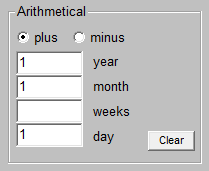BCE-BC-AD-CE Converter | ||
Windows software to convert between Julian | ||
BCE-BC-AD-CE Converter | ||
Windows software to convert between Julian | ||
This software runs on any version of Windows. It is fully-functional and not time-limited.
Donate via Stripe to download this software.

For the month,day,year format a date may have any of four year designators: AD, BC, CE and BCE (as explained below).
The Calculate button is enabled only after an input date has been fully specified (including the calendar in which it is a date). Clicking on this button then displays the input date in both the Gregorian and the Julian Calendars and in both formats (as shown in the screenshot above), plus the day of the week.
 After an input date has been completely specified you can specify a number of years, months, weeks and days to be added or subtracted from it. Clicking on the Calculate button then displays the result of adding or subtracting the specified periods to or from the input date. Years are added/subtracted first, then months, then weeks, then days. If the result would be an invalid date in a particular calendar (e.g., adding 1 month to 2011‑01‑30 CE) then that date is decremented by one day until a valid date is reached (in this example, 2011‑02‑28 CE).
After an input date has been completely specified you can specify a number of years, months, weeks and days to be added or subtracted from it. Clicking on the Calculate button then displays the result of adding or subtracting the specified periods to or from the input date. Years are added/subtracted first, then months, then weeks, then days. If the result would be an invalid date in a particular calendar (e.g., adding 1 month to 2011‑01‑30 CE) then that date is decremented by one day until a valid date is reached (in this example, 2011‑02‑28 CE).
| Traditional Christian | Religiously neutral | Common Era | ||
| 3 BC | 3 BCE | -2 CE | ||
| 2 BC | 2 BCE | -1 CE | ||
| 1 BC | 1 BCE | 0 CE | ||
| 1 AD | 1 CE | 1 CE | ||
| 2 AD | 2 CE | 2 CE |
"CE" is an abbreviation for "Common Era" (not for "Christian Era"). The suffixes "CE" and "BCE" ("Before Common Era") in the "religiously neutral" system simply replace the traditional Christian suffixes "AD" and "BC", so the "religiously neutral" system of year numbering is no different — except for the year designator — from that of the proleptic Gregorian Calendar (which is the Gregorian Calendar projected back prior to 1 AD).
Dates with negative year number are only accepted in year-month-day format, e.g., -46-03-10 CE (in the proleptic Gregorian Calendar) = -46-03-12 JC (in the proleptic Julian Calendar).
The CE year numbering system may also be used in calendars other than the proleptic Gregorian Calendar, provided some suffix is used to identify the calendar. Thus, e.g., we have "0 JC" for the year in the (proleptic) Julian Calendar (with CE year numbering) which preceded the year "1 JC". Dates in the Julian and the Gregorian Calendars mostly have the same year number, e.g. 2021-03-08 GC = 2021-02-23 JC, with the year number being different only for dates near the start or end of a year.
For historical (and other) information regarding the Gregorian and Julian Calendars see Julian and Gregorian Calendars.
For an explanation of the Julian day number displayed by the software see Julian Day Numbers.
Also: The Gregorian Calendar is a Religious Calendar